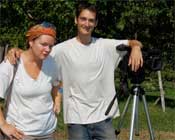“WWOOF! The Movie” is about a collective of organizations that go by the acronym WWOOF: World-Wide Opportunities on Organic Farms. My wife and I have traveled around the globe for the last 5 months and videotaped our experiences within the organizations of France, Japan, Italy, and India. The tentative delivery date for the whole sha-bang is next June, 2010.’
This is the third and final installment of my series on manual pollination in Japan from the upcoming feature, “WWOOF! The Movie”. It shows how we actually apply the pollen to the flowers. Notice the blossoms aren’t as fragile as you might expect. We really batter those flowers, like we’re fencing them with feather dusters! The blossoms are quite susceptible to damage from rain and high winds, however. That’s why they are housed in the green house instead of in the open like the rest of the fruit. Unlike the other fruit trees that you have to protect from birds and pests, the problems subside for the cherries once the fruit arrives. It’s just getting them to fruit that’s the real bugger.
We did this for about 6 hours a day, and our arms felt heavy by the end of each day. Kazu says we can’t over-pollinate them, so we just keep going back over the same trees as often as time will allow. We rotate between dusting the 2 types of cherries and the 3 types of apples on Nakagomi Orchards. They keep the varieties separate with different colored string tied around each one. There’s also a Kanji symbol telling which type it is, for those who can read them. It’s not a big deal if you mess up and pollinate the same variety with its own pollen, it’s just a waste of time. I admit, I made the mistake more than once.
Next time, we’ll be jumping back to the States for a nonlinear look at some of Oregon’s local WWOOF hosts before continuing on to India.”

Ashley Terry graduated from the University of Montana in 2004 with a degree in Broadcast Journalism and a minor in Media Arts. Since then, he has worked in broadcast news, commercial and television production houses, radio, and internet broadcasting. In 2007, he started “AT Films” as a professional wedding and event videography service provider and the business has since branched out into the world of documentary and short film production. He is currently working on a documentary called “WWOOF!” about the collective of organizations that make up the World-Wide Opportunities on Organic Farms coalition.
